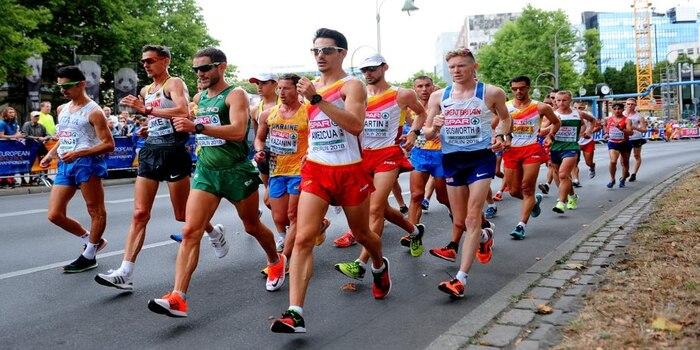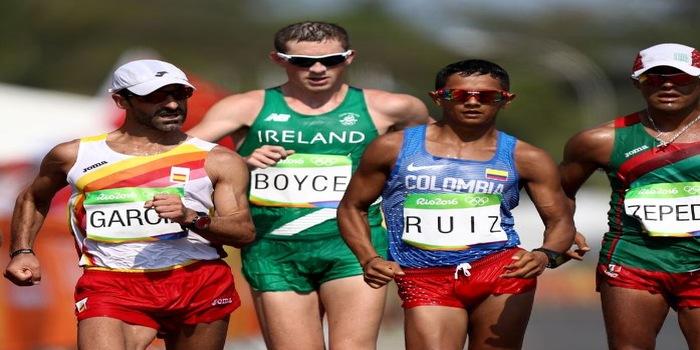Race walking is a sport that has so much to offer you. This sport might seem like a normal walking contest, but this game requires patience, discipline, and fitness.
Some so many people love race walking. Some of them participate in local contests. While others participate in the Olympic racewalking.
In this complete guide, we have covered how to get started with racewalking, its benefits, and techniques. So, here we go!
An Overview of Race Walking

Racewalking for beginners is a competitive form of walking. This sport is controlled by specific rules to ensure participants maintain a particular walking technique. Racewalking requires constant contact, unlike running, where both feet can momentarily leave the ground.
The sport is known for its speed and endurance. Race walking is often included in track and field competitions at various levels.
Rules of Race Walking
Like other sports, racewalking also has some specific rules that you must follow. Here are some important rules that you must follow:
- Your foot must always be in contact with the ground. This rule distinguishes racewalking from running.
- The forward leg must be straightened from when it makes contact with the ground until it passes under the body. However, it does not need to be completely straightened.
- The support leg can bend at the knee during the stride but must straighten at least momentarily with each step.
Top Benefits of Race Walking
Following are some of the benefits of race walking:
Provides Fitness To Your Body
Racewalking for fitness improves your heart, stamina, and cardiovascular. However, other activities like running are exercises that put less stress on your joints. This reduces the risk of injuries but still provides you with a challenging workout.
Helps In Weight Loss and Strengthen Your Muscles
Engaging in racewalking can contribute to weight management by burning calories. The intensity of this sport makes it an efficient way to increase energy and support weight loss or maintenance.
It also engages various muscle groups, including the legs, hips, core, and arms. This full-body workout helps strengthen your muscles and improve the overall body tone.
Does Not Require Expensive Equipment
It doesn't require expensive equipment or specialized facilities. You can practice race walking almost anywhere. That's why it is a convenient and accessible form of exercise.
Gives You Motivation
Yes, you hear it right. Engaging in racewalking events or setting personal goals adds a competitive element that can be motivating and sometimes rewarding. It also encourages individuals to push their limits and strive for improvement.
Want To Get Started With Race Walking? Here’s How!

Suppose you are thinking about how to get started on a racewalking journey. It would help if you considered getting a pair of comfortable walking shoes with good support. Secondly, you must understand this sport's basic rules, especially constant contact with the ground and straightening your advancing leg.
Begin with regular brisk walking sessions. Focus on maintaining a fast pace while keeping a good posture. Swing your arms naturally and avoid excessive movement.
Then comes the walking part. You should start walking with a shorter distance. Then, afterward, you can gradually increase the distance of your walks. Moreover, if you start stretching exercises, it will also improve your flexibility.
You can also find local groups where you can connect with other walkers. You can also get their guidance, and enjoy a supportive community. Furthermore, you can also participate in those local racewalking competitions to challenge yourself and stay motivated.
Techniques Used In This Sport
These are some of the techniques that you can use in racewalking training
Hip Movement
Engage your hips to create a swaying motion, which helps maintain balance and forward momentum.
Upright Posture
Keep an upright posture with a straight back. Avoid leaning forward, which is common in running.
Arm Movement
Swing your arms naturally but without crossing over the body. Meanwhile, your leading arm should not extend beyond the centerline of the body.
Heel-to-Toe Foot Placement
Land on your heel and roll through the step, pushing off with your toe. This rolling motion provides a smooth and efficient stride.
- Stride Length
Focus on a brisk stride without overstriding. Aim for a quick turnover of steps, maintaining a steady pace.
Rhythm and Tempo
Develop a consistent and efficient rhythm. Pay attention to the tempo of your steps, finding a pace that allows for speed without breaking the rules.
Controlled Breathing
Practice controlled breathing to optimize oxygen intake and support endurance during longer racewalks.
Common Mistakes to Avoid

There are also some mistakes that every beginner makes in this sport. Following are some of the common mistakes that you should avoid:
Lifting Both Of Your Legs
This is one of the biggest mistakes that every beginner walker makes. There is a strict rule that your one foot should always be in contact with the ground. If both of your feet get in the air (even for a second), and the judge notices this violation, then you may get disqualified by the judges.
Knee Bent
The second mistake that you should avoid is bending your knees. Yes, you heard it right. The knee of your leading leg, must be straight, until your leading foot touches the ground, pass and your next foot touches the ground. If your leading leg’s knee is bent, then it would be considered that you are running and this sport is about walking.
Ignoring Flexibility Training:
Try stretching exercises to increase your flexibility, especially in the hips and hamstrings. If you lack flexibility, it can affect your ability to maintain proper form.
Neglecting Racewalking-Specific Drills
Avoid skipping drills designed to enhance specific racewalking techniques. These drills help reinforce proper form and improve overall performance.
Not Seeking Guidance
Racewalking can be technical, and seeking guidance from experienced coaches or joining a racewalking group can provide valuable feedback and help you avoid developing bad habits.
Conclusion
To conclude, these were essential points if you want to know how to get started racewalking. Racewalking is a unique form of athleticism. That’s why this sport requires physical fitness and mental endurance
Whether you are a beginner or a seasoned athlete, racewalking is a sport that makes you disciplined, more endurant, and healthy
Lace your shoes, and step in racewalking. Enjoy the journey of this sport.

Health Benefits of Saffron
Oct 31, 2023

What Is Stage 3 Colon Cancer
Feb 03, 2024

A Guide To Bulgarian Split Squat for Commencing a Healthy Regimen
Mar 05, 2024

What You Should Know About Idiopathic Pulmonary Fibrosis (IPF)
Dec 21, 2023

Why Should You Choose A High-Deductible Health Plan?
Jan 13, 2024

Signs of Fibroids Breaking Down
Feb 25, 2024

Best Sleep Trackers
Dec 14, 2023

How To Begin Your Race Walking Journey
Mar 05, 2024



